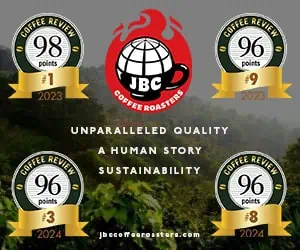Those new to espresso connoisseurship may be surprised to learn that producing this dense, aromatic beverage from coffee of a single origin rather than from a blend of coffees from different origins is a mildly controversial practice. Traditionalists argue that the espresso system extracts flavor-bearing components from coffee so efficiently that a single coffee from a single origin is not balanced and complete enough to fulfill the promise of the system. Others disagree, and support single-origins as an exciting extension of coffee globetrotting into the blend-dominated world of espresso.
Coffee Review first tested the single-origin espresso hypothesis in 2003 (Not Your Ordinary Espressos). We return to the issue again this month with the help of Heather Perry, currently America’s most prize-winning barista. (See the end of this article for a list of Heather’s championship achievements.)
Heather and I tested twenty-one single-origin coffees recommended by twenty different roasting companies for single-origin espresso production. Reviewed this month are ten of the top-rated finishers.
Inevitable Trade-Off?
The results clearly suggest that there may indeed be a trade-off with single-origin espressos: Most of those we tested clearly displayed less balance and depth of sensation than a good blend. In compensation, however, they also offered opportunities for recognition, for sensory exploration, for surprise, for the very kind of dialogue with nature and culture that blends with their usually secretive formulas tend to obscure.
Furthermore, we may not have sourced the most espresso-optimum line-up of origins. We deliberately cast a wide net in terms of coffee geography, and tested coffees not only from the more familiar coffee places in the world, but also from those less familiar, like Zimbabwe, Australia and Bali.
As more experienced readers know, Brazil is the world leader when it comes to single-origin espressos. The best Brazil dried-in-the-fruit or “natural” coffees typically make exemplary espresso: balanced, low in acidity, usually lightly syrupy in mouthfeel, with a fruit that often pleasingly reads as nut and chocolate. We did not want to be inundated with Brazils, however, so we encouraged roasters to send other origins. Fortunately, some did not listen and we are able to report on two outstanding Brazils. The La Mill Organic Brazil Serra Do Bone (91) showed a particularly deep-toned, densely textured balance and the Ecco Caffe Brazil Fazenda Sao Joao (90) a delicate, fruit-toned complexity.
Processing Method, Espresso Preparation and Roasting
Regardless of origin, coffee that has been dried in the fruit (dry-processed or “natural” coffee) often shows better as espresso than wet-processed or “washed” coffee, which has had most of the fruit removed before drying. Dried-in-the-fruit coffee is typically a bit more viscous in mouthfeel with more sugar and more tendency to low-toned, low-acid fruit. This month’s Victrola Ethiopia Harar Moplaco (90) is a fine example of the fruitier style of dry-processed, single-origin espresso. The fruit notes in the Barefoot Ethiopia Ghimbi Wollega (88) were striking but the shot was rather lean in mouthfeel and sharp in structure, perhaps owing to a roast just a bit too light to quiet and round the coffee for presentation as espresso.
Wet-processed coffees may not always shine as single-origin espressos because this processing method tends to reduce viscosity and while encouraging acidity, the sweetly tart sensation that may read as pleasingly bright and crisp in coffee brewed as drip or French press, but can be grating and sharp in espresso. When wet-processed coffees are offered as single-origin espressos, roasters often choose origins that tend to lean toward moderate acidity and high sweetness, like the two El Salvadors reviewed this month. The Stone Cup El Salvador Los Planes (90), at a medium roast, was a bit lean in mouthfeel but delicately complex and nuanced as espresso. On the other hand, the Barefoot Coffee El Salvador Finca San Jose was brought to an even lighter roast that showcased the shimmering acidy delicacy of this fine coffee, but at the cost of body in the small cup and presence in milk. Finally, the slowly achieved, medium-dark roast style of the wet-processed Pacific Bay Coffee Guatemala Finca El Injerto (90) probably contributed greatly to this coffee’s success in an espresso preparation, particularly to its deep presence in milk.
Espresso-Nuanced Processing
Some green coffee producers deliberately pursue processing practices designed to maximize their coffee’s potential for espresso brewing. This month’s most successful example of such thoughtful manipulation is the Leopard Forest Sable Espresso, made up entirely of high-grown coffee from a single farm in Zimbabwe, but manipulated both in terms of roast (a blend of different roast levels) and processing method (a blend of coffees prepared by both processing methods, wet and dry). The result is a balanced, complex espresso with great presence in milk.
The Australia XF 2007 Bundja, offered as a single-origin espresso by PT’s Coffee (88), is an espresso-friendly green coffee type produced mainly from fruit already dried or partly dried on the tree and subsequently soaked and scrubbed free of the rewetted fruit residue. The result is a very interesting coffee, naturally sweet, but one, in this incarnation at least, dominated by a smoky, musty note that I assume the beans picked up while drying inside the fruit and on the tree, a note that I found more attractive than did Heather.
Despite the very wide range of origin and coffee style in our sampling, I was disappointed not to turn up any high-end Indian robustas offered as single-origin espressos. These low-toned, big-bodied, nut-nuanced coffees can make splendid one-farm espressos, as can monsooned Indian coffees and traditional Sumatra coffees, also no-shows in this month’s sampling.
Co-Taster and Champion Barista Heather Perry
Heather and I conducted the tasting at the Coffee Klatch training room in southern California. We broke the tasting into two sessions over two days, aiming to test about ten espressos per session. Tasting espressos is obviously is a much slower and more deliberate process than cupping coffees, as the grinder needs to be meticulously recalibrated for each sample.
Fortunately, this process took about half as long as it would in my lab, since Heather clearly is one of the world’s finest baristas, as deft and efficient as she is knowledgeable and nuanced. She has a wall of trophies as competition barista: two United States championships (2003 and 2007), a very respectable third-place finish in 2008, four regional Western championships, and second place in the 2007 Tokyo world championship, the best showing to date by a U.S. contestant and by a woman. Heather, the daughter of Coffee Klatch Roasting’s Mike Perry, has recently started her own training company, Best Barista Training.
Tasting Protocol
These tastings were conducted using almost identical procedures and equipment as used in the usual Coffee Review tastings: a La Marzocco semi-automatic machine with brewing temperature set at 200 degrees Fahrenheit using a double filter producing two approximately 1-ounce shots in 25 to 30 seconds after the first drop. The only change in our usual practice was occasioned by Heather’s accomplished dosing technique, which involves settling the coffee by gently bouncing the portafilter as it fills, which netted about two more grams coffee per double dose than produced by the leveling technique we use at Coffee Review, for a typical dose of approximately 19 grams per double shot rather than the usual Coffee Review 17 grams.
2008 The Coffee Review. All rights reserved.










